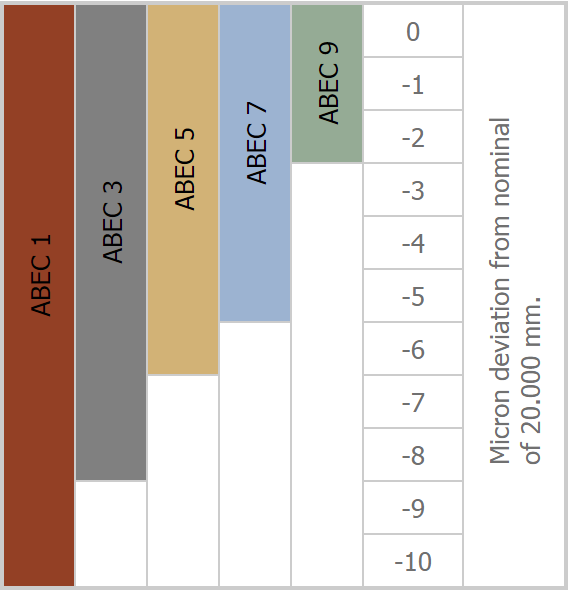ABEC Scale on:
[Wikipedia]
[Google]
[Amazon]
The ABEC scale is an industry accepted standard for the tolerances of a
 For illustration, the figure shows the differences in tolerance per ABEC class in
For illustration, the figure shows the differences in tolerance per ABEC class in differences between the ABEC classes
provided by GMN Bearings A 20 mm ABEC 7 bearing only has a 5 μm tolerance window, whereas an ABEC 1 has twice as wide a tolerance.
ball bearing
A ball bearing is a type of rolling-element bearing that uses balls to maintain the separation between the bearing races.
The purpose of a ball bearing is to reduce rotational friction and support radial and axial loads. It achieves this ...
. It was developed by the Annular Bearing Engineering Committee (ABEC) of the American Bearing Manufacturers Association (ABMA). The ABEC scale is designed to provide bearing manufacturers dimensional specifications that meet the standards of precision bearings in a specified class. Manufacturers who produce equipment that require bearings must also know the dimensional tolerances to design parts that will accommodate a bearing.
There are five classes from largest to smallest tolerances: 1, 3, 5, 7, 9. The higher ABEC classes provide better precision, efficiency, and the possibility of greater speed capabilities, but do not necessarily allow the components to spin faster. The ABEC rating does not specify many critical factors, such as load handling capabilities, ball precision, materials, material Rockwell hardness, degree of ball and raceway polishing, noise, vibration, and lubricant. Due to these factors, an ABEC 3 classified bearing could perform better than an ABEC 7 bearing. Bearings not conforming to at least ABEC 1 cannot be classified as precision bearings as their tolerances are too loose.
The scale also works as a guide for consumers to make informed decisions about the type of bearing they desire, despite not knowing factors related to materials, manufacturing, and performance.
High rated bearings are intended for precision applications like aircraft instruments or surgical equipment. Lower graded bearings are intended for the vast majority of applications such as vehicles
A vehicle (from la, vehiculum) is a machine that transports people or cargo. Vehicles include wagons, bicycles, motor vehicles (motorcycles, cars, trucks, buses, mobility scooters for disabled people), railed vehicles ( trains, trams), ...
, mechanical hobbies
A hobby is considered to be a regular activity that is done for enjoyment, typically during one's leisure time. Hobbies include collecting themed items and objects, engaging in creative and artistic pursuits, playing sports, or pursuing oth ...
, skates, skateboard
A skateboard is a type of sports equipment used for skateboarding. They are usually made of a specially designed 7-8 ply maple plywood deck and polyurethane wheels attached to the underside by a pair of skateboarding trucks.
The skateboar ...
s, fishing reels and industrial machinery. High ABEC rated bearings allow optimal performance of critical applications requiring very high RPM and smooth operation.
ISO's equivalent standard is ISO 492. The German equivalent is DIN
DIN or Din or din may refer to:
People and language
* Din (name), people with the name
* Dīn, an Arabic word with three general senses: judgment, custom, and religion from which the name originates
* Dinka language (ISO 639 code: din), spoken by ...
620. The Japanese equivalent is JIS B1514.
Bearing Tolerance Illustrated
 For illustration, the figure shows the differences in tolerance per ABEC class in
For illustration, the figure shows the differences in tolerance per ABEC class in µm
The micrometre ( international spelling as used by the International Bureau of Weights and Measures; SI symbol: μm) or micrometer (American spelling), also commonly known as a micron, is a unit of length in the International System of Unit ...
for a 20 mm inner diameter bearing.provided by GMN Bearings A 20 mm ABEC 7 bearing only has a 5 μm tolerance window, whereas an ABEC 1 has twice as wide a tolerance.
References
{{DEFAULTSORT:Abec Scale Bearings (mechanical)